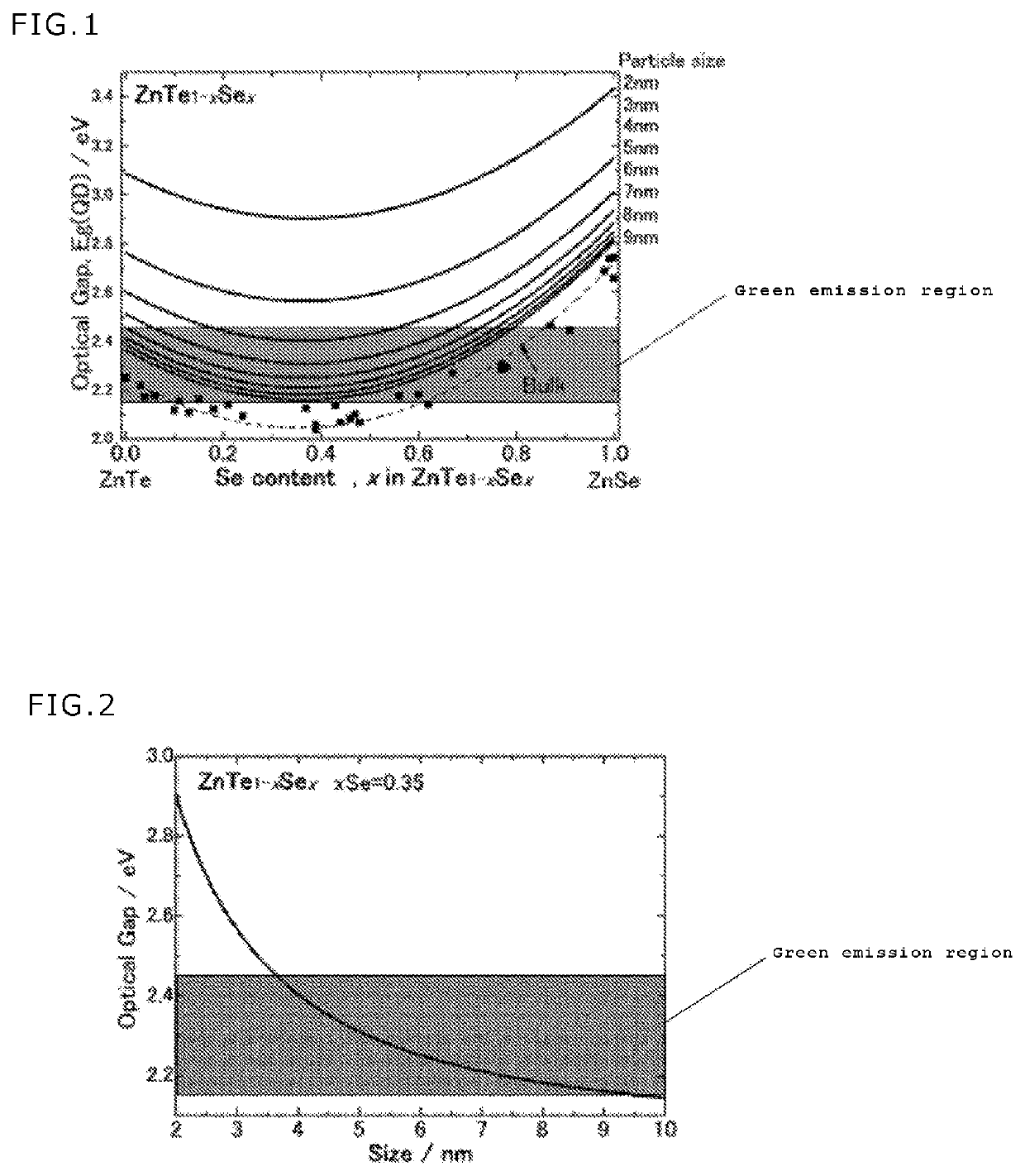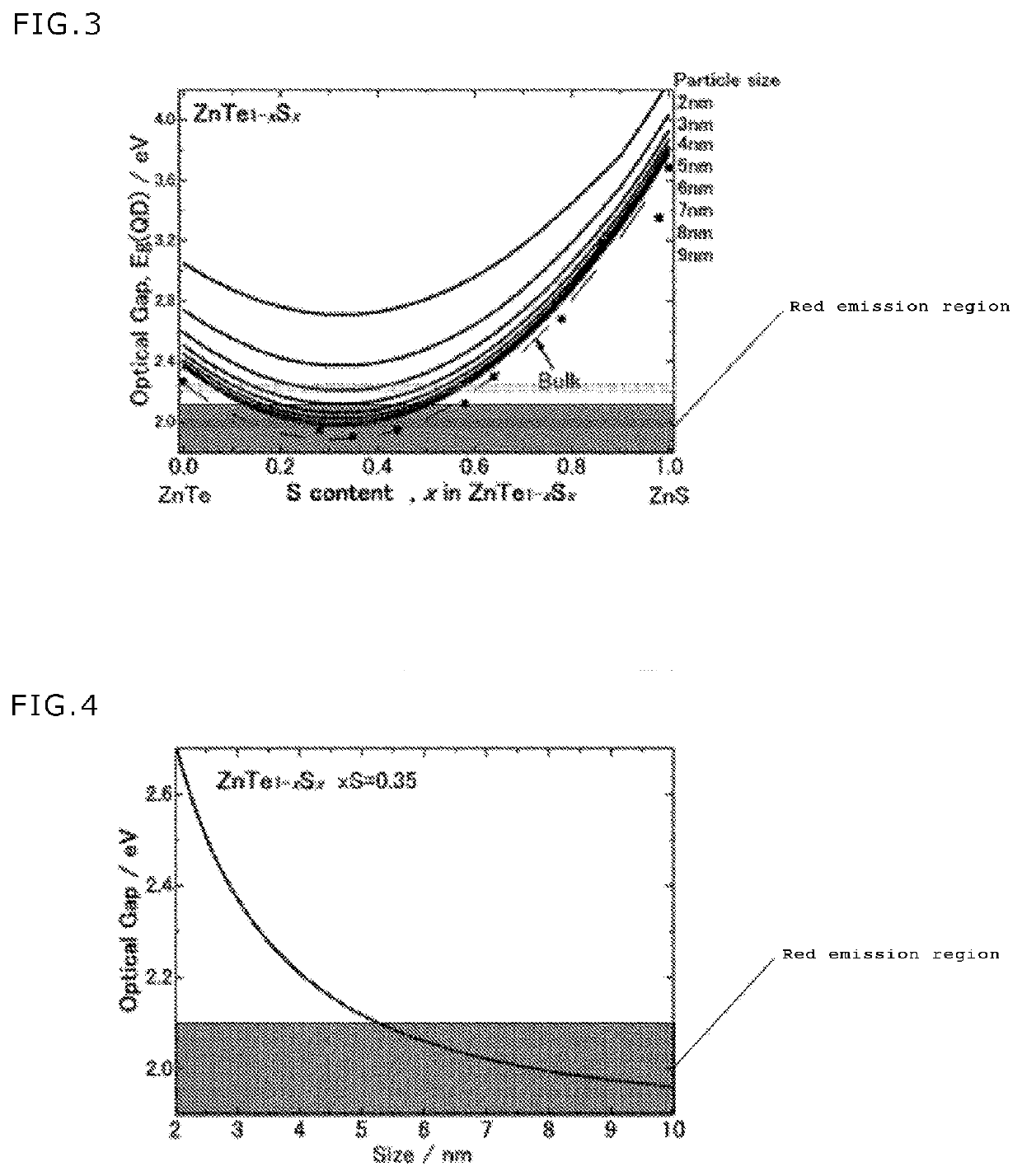Cd-free colloidal quantum dot capable of emitting visible fluorescence, and method for producing same
a colloidal quantum and fluorescence technology, applied in the field of colloidal quantum dots, can solve the problems of significant reduction in efficiency, difficult to extend the color gamut in green and red regions, and toxicity of such regions, and achieve the effects of improving color purity, reducing energy loss, and good chromaticity
- Summary
- Abstract
- Description
- Claims
- Application Information
AI Technical Summary
Benefits of technology
Problems solved by technology
Method used
Image
Examples
first embodiment
[0043][Method for Producing Zn(Te1-x, Sex) Colloidal Quantum Dot Capable of Emitting Green Light as Visible Fluorescence]
[0044]A method for producing a colloidal quantum dot capable of emitting green light as visible fluorescence of the first embodiment is a method producing a Cd-free colloidal quantum dot capable of emitting green light as visible fluorescence, including heating any one of a liquid prepared by mixing a Zn source liquid, a Te source liquid, and a Se source liquid, and a liquid prepared by mixing a capping agent with a diluent to a temperature of 200° C. to 350° C., injecting into the heated liquid a predetermined amount of the other liquid under a nonoxidative atmosphere, adjusting the temperature of the liquid obtained by injecting the other liquid to the heated liquid to 200° C. to 350° C., and holding the liquid for one minute to five hours.
[0045]As an example, the method of the first embodiment includes steps of (a) mixing a Zn source liquid, a Te source liquid,...
second embodiment
[0054][Method for Producing Zn(Te1-x, Sx) Colloidal Quantum Dot Capable of Emitting Red Light as Visible Fluorescence]
[0055]A method for producing a colloidal quantum dot capable of emitting red light of the second embodiment is a method producing a Cd-free colloidal quantum dot capable of emitting red light as visible fluorescence, including heating any one of a liquid prepared by mixing a Zn source liquid and a Te source liquid, and a liquid prepared by mixing a S source liquid, a capping agent, and a diluent to a temperature of 200° C. to 350° C., injecting into the heated liquid a predetermined amount of the other liquid under a nonoxidative atmosphere, adjusting the temperature of the liquid obtained by injecting the other liquid to the heated liquid to 200° C. to 350° C., and holding the liquid for one minute to five hours.
[0056]As an example, the producing method of the second embodiment includes steps of (a) mixing a Zn source liquid and a Te source liquid to prepare a third...
example 1
[0074][Synthesis of Zn(Te1-x, Sex) Colloidal Quantum Dot]
[0075]For synthesis of a Zn(Te1-x, Sex) colloidal quantum dot, a series of operations from weighting of the reagents to completion of synthesis was performed in a glove box which was mainly filled with a nitrogen gas. Some operations outside the glove box were performed in a closed container filled with a nitrogen gas so that a solution was not in contact with air.
[Preparation of Source Solution]
[0076]1.9142 g (15 mmol) of Te powder and 50 mL of TOP were weighed in a three-neck flask, then heated to 250° C. while an argon gas was bubbled, and stirred until the Te powder was completely dissolved to be yellow transparent. After the dissolution, the solution was allowed to cool to room temperature, to obtain a Te source liquid. 1.1845 g (15 mmol) of Se powder and 50 mL of TOP were weighed in a vial and placed in an ultrasonic cleaner, and the Se powder was completely dissolved to obtain a colorless transparent Se source liquid. T...
PUM
| Property | Measurement | Unit |
|---|---|---|
| particle diameter | aaaaa | aaaaa |
| particle diameter | aaaaa | aaaaa |
| temperature | aaaaa | aaaaa |
Abstract
Description
Claims
Application Information
 Login to View More
Login to View More - R&D
- Intellectual Property
- Life Sciences
- Materials
- Tech Scout
- Unparalleled Data Quality
- Higher Quality Content
- 60% Fewer Hallucinations
Browse by: Latest US Patents, China's latest patents, Technical Efficacy Thesaurus, Application Domain, Technology Topic, Popular Technical Reports.
© 2025 PatSnap. All rights reserved.Legal|Privacy policy|Modern Slavery Act Transparency Statement|Sitemap|About US| Contact US: help@patsnap.com


